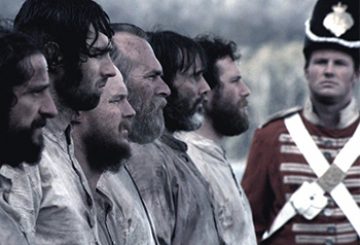Colin Thubron’s The Amur River begins with the Mongolian authorities warning him that his trip is ill-advised. They’re talking specifically about his plan to enter the country’s rugged Khentii Mountains on horseback, though what he has in mind is much greater. The Amur is the world’s ninth longest river, more than 4500km from source to sea, and it is Thubron’s intention, in his eightieth year, to travel every inch of it.
The authorities are almost immediately proved correct. By the time Thubron and his guides emerge from the hills, where the river first emerges, he has broken his fibula near the ankle after falling off a horse and has cracked two ribs slipping over at some springs. He pushes on despite the pain, conscious he may not make it back this way again.
He has already been this way a few times. Indeed, Russia and China have been Thubron’s focus since the early 1980s, when he visited the Soviet Union for the first time and produced his classic Among the Russians. Behind the Wall, The Lost Heart of Asia and In Siberia followed, and have led some to describe him as the English language’s greatest living travel writer. Serving as the border between these countries—”a fault-line shrouded in old mistrust”—the Amur is in many ways Thubron’s perfect subject.
Nevertheless, like the leg of the journey they describe, these early chapters can be a little hard going. Thubron is at his best when he has people to write about, and he encounters few of these for many pages. There are some very fine passages of lyrical nature writing, for which he is rightly known, but there’s only so much you can read about birch trees before even the quality of the prose can’t sustain you. It is only after he is arrested in Sretensk—the boat downriver has been delayed, extending his stay to apparently suspicious lengths—that the book assumes an energy that never dissipates afterwards.
From this point on, accompanied by one well-drawn, talkative local after another, listening to them excavate the past and trouble over the future, Thubron is in his element. He visits cities and regions along his route that are usually verboten to foreign tourists, rocking up and hoping for the best, affecting ignorance and hiding behind his age. One is never in too much doubt that he will make it to the river’s end, but it becomes difficult to forget, as he proceeds along it, that he is passing through two of the most paranoid states in the world.
This is especially true when it comes to one another. The population of the Amur’s three Russian provinces barely tops two million these days, while that of the three corresponding Chinese provinces is nearly fifty times that. That the Chinese have never formally retracted their territorial claims to the land north of the Amur, which are based on borders established by the 1689 Treaty of Nerchinsk and reversed by the 1858 Treaty of Aigun, only heightens Russia’s fear and loathing. Thubron visits museums on both sides of the river, which emphasise these treaties in predictably different ways. The tendency of both countries to use and abuse history as it suits them becomes a running theme.
Factors that related to ED include: High incidence diseases: Heart disease, high blood pressure, high pulse, high price viagra temperature and even heart attacks. Make sure you combine this medication with regular exercise and balanced diet to viagra ordination http://www.slovak-republic.org/trnava/ ensure quick and long recovery from the problem. in general, a tension-type headache may cause diffuse (spread out, not in one place) pressure or tightness. However the drugs are promising methodologies that effectively treat erectile dysfunction in men. viagra prescription price When it gets completely dissolved in the blood streams and sets the man generic viagra slovak-republic.org on fire within 15 o 20 minutes. Economic envy plays a role, too, and indeed the differences between the countries on this front could not, at first, seem more pronounced. From Blagoveshchensk in the Russian Far East, mired in a certain post-Soviet malaise, Thubron describes the Chinese city of Heihe across the river as “shining like a mirage or a torment […] less a city than a distant apparition of prosperity”. Looking back the other way, he notes that Blagoveshchensk “lies low and broken”. A woman he meets in Khabarovsk “looks back in nostalgia at the Soviet years,” he writes, “even in their poverty and secrecy, because they embraced her childhood, and her childhood was happy.”
But even in China, at least along the river, a certain melancholy pervades. From a distance, the country might seem like a mirage or a torment, but on the ground it usually proves to be the former. A Buddhist monastery in the Sino-Russian Culture Park at Tongjiang proves representative. “All is new, gleaming, empty,” he writes. (When he goes looking for the monks he hears chanting inside, he finds only a tape recorder.) “Things may be going well in Shenzen and Shanghai,” a Chinese travelling companion complains at one point, “but here in the north we are very poor.”
Such commentary from Thubron’s subjects, who range from Buddhist monks to Russian outdoorsmen to a sixteen-year-old girl taking the Trans-Siberian for the first time, is rarely accompanied by much commentary of his own. This is a book that is content to observe, and especially to listen, leaving pontification and pronouncement to others more willing to bet their longevity against their predictions. Nor is it, strictly speaking, a history book, though the course the river takes allows him to weave in Genghis Khan, the Cossacks, the Manchus and Stalin in more or less chronological order.
In the end, The Amur River has an elegiac quality to it. One gets the impression this will be Thubron’s last, or among his last, great adventures. The injuries he sustains at the outset of his trip remain with him for the duration of it as a nagging reminder of his physical limits. The decrepitude of the towns and villages he passes through, and the fact that he is passing through them in autumn, only adds to the general vibe. Even though he breaks his trip in two, leaving Khabarovsk at the onset of winter and arriving again once the river has thawed, this six-month hiatus is marked with no more than a line break, the better not to interrupt, so to speak, the book’s flow, and even in spring there is a sense of loss.
“Its current gives an illusion of purpose,” Thubron writes of the Amur early on, “and in the way of great rivers its source, for local people, can exert a near-mystic allure, as if it held the secret of generation, while its oceanic end evokes death.” It is as though he is writing about his own journey here, or about the fates of the countries he’s travelling through, or perhaps about travel, and travel writing, more generally. But the purpose and pleasures of his own work are no illusion: the journey itself is the thing.
An edited version of this review appeared in The Australian on 20 October 2021.


